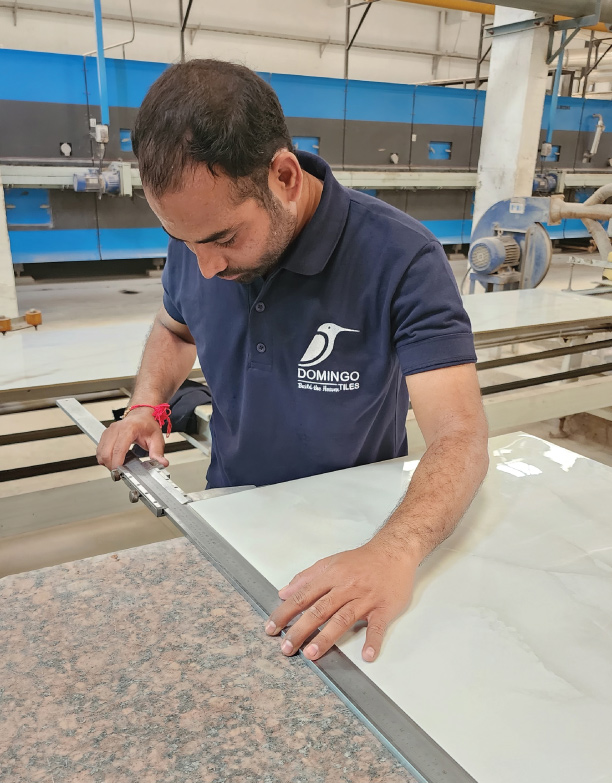
Quality control in the tiles industry is a critical process that ensures tiles meet specific standards, specifications, and customer requirements. It involves a range of activities and tests aimed at maintaining consistent quality, improving manufacturing processes, and delivering tiles that are aesthetically pleasing, durable, and functional.
We provide transparency in our methods and work to satisfy customers requirements. Continuously improve the effectiveness of both the quality management system and the provision of our all products and service.
We follow International STD ISO13006/EN 176 Group Bla for products testing. Here's an overview of quality control practices for our products:


Whiteness Test
A whiteness test for porcelain tiles is a method used to assess the degree of whiteness or lightness of the surface of the tiles. It's an important quality control measure in the tile manufacturing industry to ensure consistency and quality of the final products. The test involves measuring the light reflectance properties of the tile's surface, which is closely related to its perceived whiteness.
A whiteness meter, also known as a colorimeter or spectrophotometer, is used to perform the test. This device is capable of measuring the intensity of light reflected off the tile's surface across different wavelengths. By conducting whiteness tests, manufacturers can ensure that their porcelain tiles meet the desired aesthetic and quality standards. This is particularly important for industries like architecture, interior design, and construction, where the visual appeal of tiles plays a significant role.
Deviation in length and width test
Deviation in length and width tests for porcelain tiles is a quality control process used to assess the dimensional accuracy and consistency of the tiles. These tests help ensure that the tiles meet the specified size requirements and adhere to industry standards. Deviation in length and width refers to the allowable variation in size measurements compared to the intended dimensions.
To perform these tests, we use precision measuring instruments, such as calipers, micrometers, or digital measuring tools. These tools allow for accurate measurements of length and width. By conducting deviation in length and width tests, manufacturers can identify any discrepancies in the tile sizes and take corrective actions to maintain product quality and consistency. This helps ensure that the tiles are suitable for their intended use and meet the expectations of architects, designers, and end-users.
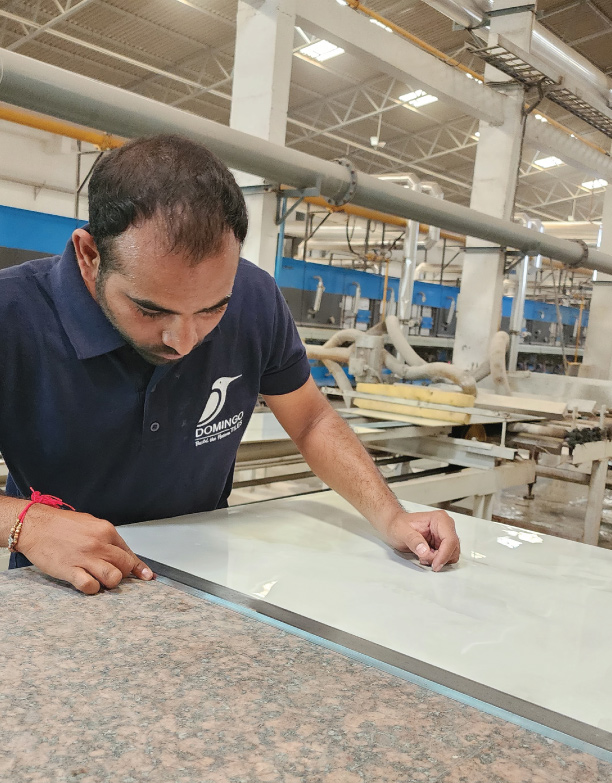

Glossiness Test
The glossiness test for porcelain tiles is a quality assessment procedure that measures the reflective property of the tile's surface. Glossiness refers to the ability of a surface to reflect light uniformly in a specular (mirror-like) manner, creating a shiny and polished appearance. This test is crucial in evaluating the aesthetic and functional aspects of porcelain tiles.
A gloss meter, also known as a Glossmeter, is used for this test. This device is specifically designed to measure gloss and shine. It consists of a light source that directs light onto the tile's surface at a specific angle and a receiver that measures the amount of light reflected off the surface. Glossiness testing is an essential part of quality control in the production of porcelain tiles. It helps manufacturers maintain consistent visual characteristics across their products and ensures that tiles meet the expected level of shine.
Stain Test
The stain test for porcelain tiles is a method used to assess the tile's resistance to staining from various substances. Porcelain tiles are often used in spaces where they might come into contact with liquids, oils, and other materials that could potentially cause stains. This test helps evaluate the tile's ability to repel or resist absorption of these substances, maintaining the aesthetic appeal and cleanliness of the tile's surface.
A range of substances that are likely to come into contact with the tile's surface is chosen for the test. These substances can include common household items like red wine, coffee, ketchup, oil, ink, and more. The goal is to simulate real-life scenarios that might cause stains.
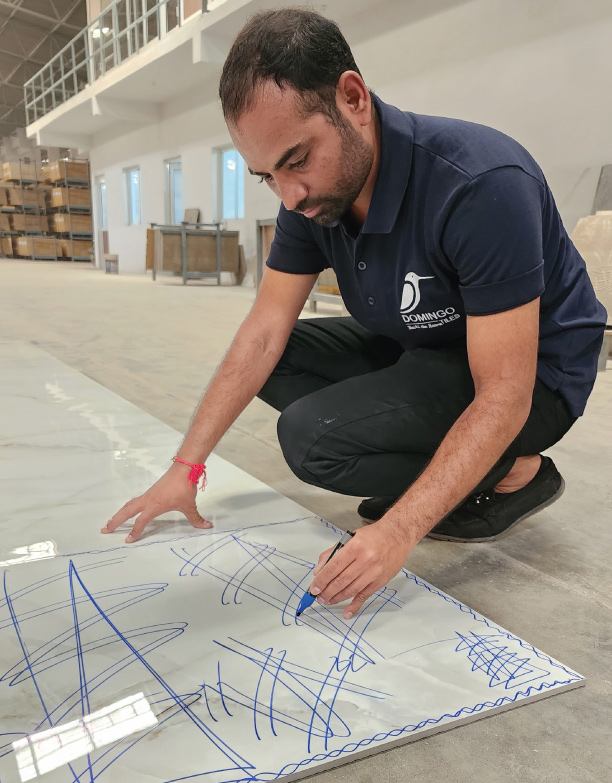
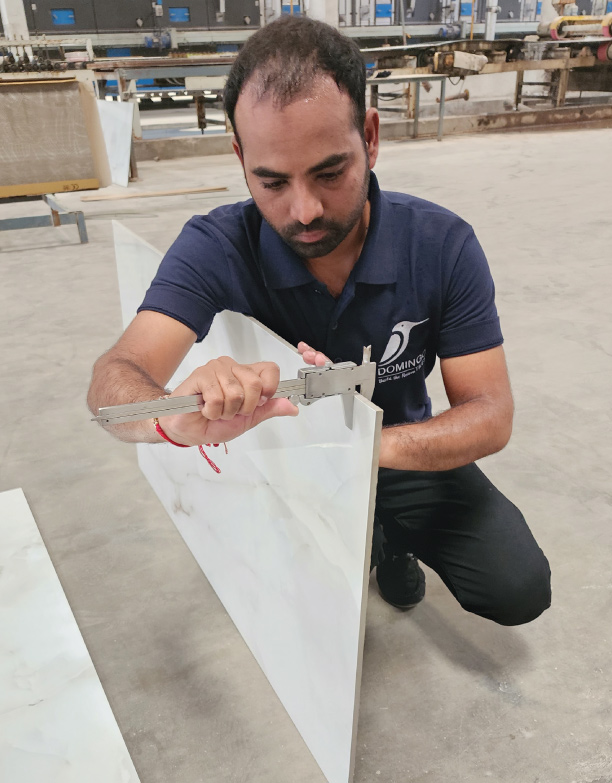
Deviation in Thickness Test.
Deviation in thickness refers to the variation or difference in the thickness of porcelain tiles within a given batch or lot. Porcelain tiles are manufactured to certain standards and specifications, including their thickness. However, due to the inherent nature of manufacturing processes and materials, there can be slight variations in the thickness of tiles even within the same production run.
Deviation in thickness can be measured and quantified using precision instruments such as calipers or digital thickness gauges. This involves measuring the thickness of multiple tiles from the same batch at different points on each tile and then calculating the range of thicknesses observed.
It's important to note that deviations in thickness are often expressed as tolerances. For example, a tile might have a thickness specification of 9mm with a tolerance of ±0.5mm. This means that the actual thickness of the tile can vary between 8.5mm and 9.5mm while still meeting the specified standards. In summary, deviation in thickness for porcelain tiles refers to the slight variations in tile thickness that can occur during the manufacturing process.
Flexural Strength test
The flexural strength test for porcelain tiles is a crucial mechanical test that measures the tile's ability to resist bending or flexing without breaking. This test helps assess the tile's structural integrity and its suitability for various applications, especially in situations where tiles might be subjected to bending forces, such as when installed on floors or walls. The test involves applying a controlled load to a supported tile specimen until it fractures.
Place the tile specimen on the bending fixture with its glazed surface facing upwards. The support points should be positioned under the tile at specific distances from each other, and the loading point should be placed on the centerline of the span between the support points. Gradually apply a force or load at a constant rate onto the center of the tile using a hydraulic or mechanical testing machine. The rate of loading is controlled to apply stress to the tile in a consistent manner. The test continues until the tile specimen fractures. The point at which the tile breaks and the applied force at that point are recorded. This breaking point provides information about the maximum load the tile can withstand before failure.
The calculated flexural strength value provides insight into the tile's ability to resist bending forces. It helps determine whether the tile meets the required standards for its intended application. Tiles with higher flexural strength values are generally more durable, suitable for high-stress environments with ensure long-lasting performance and safety.

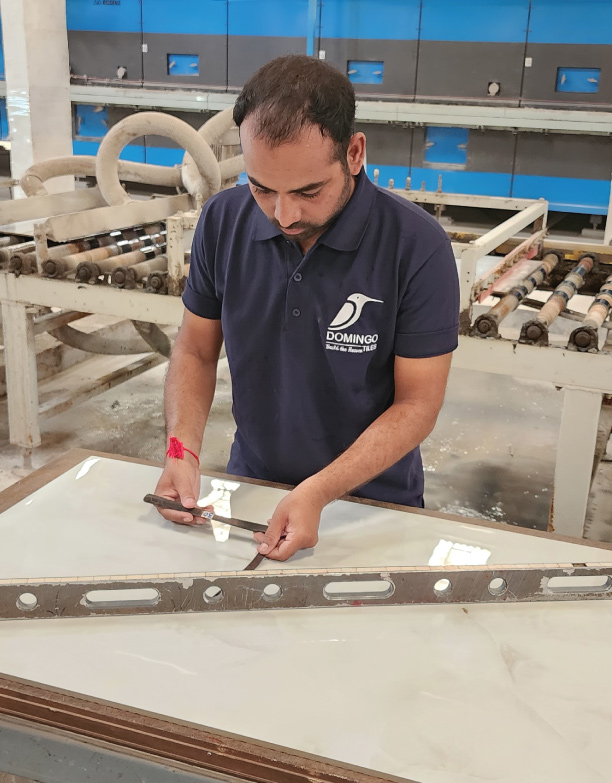
Surface Flatness Test
Surface flatness, also known as surface profile or surface evenness, is an important characteristic of porcelain tiles, especially when they are used in applications where a smooth and level surface is essential, such as flooring or wall cladding. The surface flatness test for porcelain tiles assesses how level and uniform the tile's surface is, helping to ensure a visually appealing and functionally sound installation. Here's how the test is typically conducted:
A surface flatness testing apparatus is used to measure deviations from a perfectly flat plane. This can be a specialized device designed for this purpose or a simpler tool like a straightedge and a feeler gauge. Place the selected tile on a flat and level surface with its glazed side facing upwards. Ensure that the tile is well-supported and stable. Place a straightedge, which is a long and straight tool, on the tile's surface. Then, use a feeler gauge to measure the gap between the straightedge and the tile's surface at various points. The feeler gauge will indicate any deviations from a flat plane.
More advanced methods involve using laser levels or digital scanners to capture the tile's surface profile digitally. These methods provide detailed visual representations of surface deviations. Surface flatness testing is crucial to ensure a visually pleasing installation and to prevent issues like uneven surfaces, lippage (when the edges of adjacent tiles are not level), and difficulties during grout application. Properly assessing and addressing surface flatness can contribute to the long-term durability and aesthetics of a porcelain tile installation.
Rectangularity test
The rectangularity test for porcelain tiles evaluates how closely a tile's edges and corners conform to a true rectangular shape. This test is important because tiles with accurate rectangularity are easier to install, resulting in consistent grout lines and a visually pleasing finished appearance. The test helps ensure that tiles fit together tightly and evenly, minimizing the potential for lippage (uneven edges between adjacent tiles).
A rectangularity gauge or template is used to assess the tile's conformity to a true rectangular shape. This template typically consists of two perpendicular arms that form a right angle. Place the selected tile on a flat and level surface with its glazed side facing upwards. Position the rectangularity gauge or template over the tile in such a way that the arms of the gauge align with the edges of the tile. Compare the edges and corners of the tile to the gauge or template. This is a qualitative assessment of how well the tile's shape matches the right angle formed by the template.
Rectangularity testing helps ensure that the tiles fit together tightly and evenly during installation, creating a cohesive and visually pleasing surface. It's particularly important for applications where precise alignment is crucial, such as large-format installations. By assessing and categorizing tiles based on their rectangularity, manufacturers and users can make informed decisions about how to use the tiles effectively and achieve the desired aesthetics and functionality in their projects.
